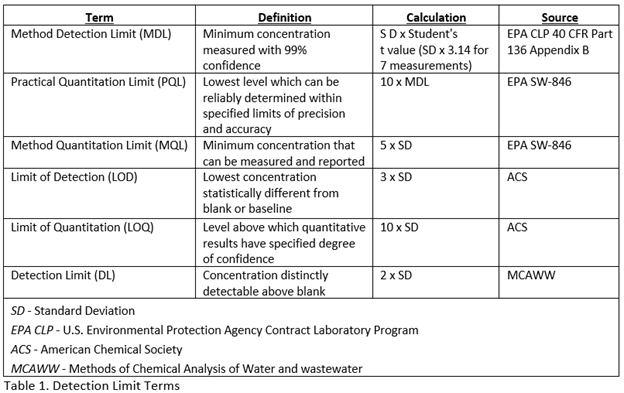
Quantitative analysis determines the concentration of a target analyte present in a test sample. Detection limits and quantitation limits are used to express the ability of the instrumentation and the accuracy of the analytical results. This blog provides a brief overview on guidelines and references for achieving applicable detection limits and reliable quantitation limits.
Detection limits can be derived from several well-documented sources (table 1). The procedures typically used for Total Organic Carbon (TOC) analysis at Teledyne Tekmar are Limit of Detection (LOD) and Limit od Quantitation (LOQ) as defined by the American Chemical Society (ACS).
LOD is the lowest concentration statistically different from a blank or the baseline. The calculation used to obtain the LOD is the standard deviation (SD) of several (at least three) analysis replicates multiplied by three (3 x SD). LOD is commonly referred to as sensitivity measurement.
LOQ is the level above which quantitative results have specified degree of confidence. LOQ represents the lowest analyte concentration in a sample that can be detected with acceptable accuracy and precision. The calculation used to obtain the LOQ is the standard deviation (SD) of several (at least three) analysis replicates multiplied by ten (10 x SD). LOQ is considered a stability measurement.

Another widely used and commonly accepted procedure for establishing sensitivity of an analytical instrument is Method Detection Limit(MDL) as defined by the United States Environmental Protection Agency (USEPA) in 40 CFR Part 136 Appendix B. MDL is the minimum concentration of a substance in which it can be measured and reported with 99% confidence that the analyte concentration is greater than zero and is determined from analysis of a sample in a given matrix containing the analyte. The calculation used to obtain the MDL is the standard deviation of the analysis replicates multiplied by Student’s t value (SD x 3.14 for seven measurements).
The MDL is determined by spiking blanks with known amounts of the target analyte. The lowest possible concentration of the spike for detection based on precision will result in the lowest possible MDL. For calculated MDLs to be relevant and acceptable as defined by the USEPA, the MDL for the target analyte must comply with the first rule as follows:
Rule 1: The calculated MDL must be less than the spike concentration and greater than one-tenth the spike concentration. (1/10 spike < MDL < spike)
If the calculated MDL is greater than the spike concentration, then the MDL study must be repeated at a higher spike concentration. If the calculated MDL is less than one-tenth the spike concentration (or 10 x MDL is less than the spike), then the MDL study must be repeated at a lower spike concentration.
While MDL is a statistical calculation of an instrument’s sensitivity, the stability measurement ability of the instrument is expressed as the Practical Quantitation Limit (PQL). According to USEPA SW-846, PQL, like LOQ, is the lowest level which can be reliably determined within specified limits of accuracy and precision. The calculation used to obtain the PQL is MDL multiplied by 10.
Understanding and applying the appropriate limits to instrumentation and analytical results enables researchers and laboratories to provide relevant detection limits and reliable quantitation limits, which in turn generates respectable and defendable results.
For more information on Tekmar products, click the button below.
